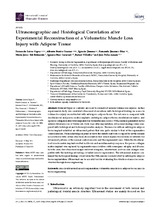Mostrar el registro sencillo del ítem
Ultrasonographic and Histological Correlation after Experimental Reconstruction of a Volumetric Muscle Loss Injury with Adipose Tissue
| dc.contributor.author | Leiva-Cepas, Fernando | |
| dc.contributor.author | Benito‐Ysamat, Alberto | |
| dc.contributor.author | Jimena Medina, Ignacio | |
| dc.contributor.author | Jiménez-Díaz, Fernando | |
| dc.contributor.author | Gil‐Belmonte, María Jesús | |
| dc.contributor.author | Ruz‐Caracuel, Ignacio | |
| dc.contributor.author | Villalba, Rafael | |
| dc.contributor.author | Peña Amaro, J. | |
| dc.date.accessioned | 2021-06-23T11:45:49Z | |
| dc.date.available | 2021-06-23T11:45:49Z | |
| dc.date.issued | 2021 | |
| dc.identifier.uri | http://hdl.handle.net/10396/21435 | |
| dc.description.abstract | Different types of scaffolds are used to reconstruct muscle volume loss injuries. In this experimental study, we correlated ultrasound observations with histological findings in a muscle volume loss injury reconstructed with autologous adipose tissue. The outcome is compared with decellularized and porous matrix implants. Autologous adipose tissue, decellularized matrix, and a porous collagen matrix were implanted in volumetric muscle loss (VML) injuries generated on the anterior tibial muscles of Wistar rats. Sixty days after implantation, ultrasound findings were compared with histological and histomorphometric analysis. The muscles with an autologous adipose tissue implant exhibited an ultrasound pattern that was quite similar to that of the regenerative control muscles. From a histological point of view, the defects had been occupied by newly formed muscle tissue with certain structural abnormalities that would explain the differences between the ultrasound patterns of the normal control muscles and the regenerated ones. While the decellularized muscle matrix implant resulted in fibrosis and an inflammatory response, the porous collagen matrix implant was replaced by regenerative muscle fibers with neurogenic atrophy and fibrosis. In both cases, the ultrasound images reflected echogenic, echotextural, and vascular changes compatible with the histological findings of failed muscle regeneration. The ultrasound analysis confirmed the histological findings observed in the VML injuries reconstructed by autologous adipose tissue implantation. Ultrasound can be a useful tool for evaluating the structure of muscles reconstructed through tissue engineering. | es_ES |
| dc.format.mimetype | application/pdf | es_ES |
| dc.language.iso | eng | es_ES |
| dc.publisher | MDPI | es_ES |
| dc.rights | https://creativecommons.org/licenses/by/4.0/ | es_ES |
| dc.source | International Journal of Molecular Sciences 22(13), 6689 (2021) | es_ES |
| dc.subject | Muscle ultrasound | es_ES |
| dc.subject | Muscle regeneration | es_ES |
| dc.subject | Volumetric muscle loss | es_ES |
| dc.subject | Adipose tissue | es_ES |
| dc.subject | Muscle tissue engineering | es_ES |
| dc.title | Ultrasonographic and Histological Correlation after Experimental Reconstruction of a Volumetric Muscle Loss Injury with Adipose Tissue | es_ES |
| dc.type | info:eu-repo/semantics/article | es_ES |
| dc.relation.publisherversion | http://dx.doi.org/10.3390/ijms22136689 | es_ES |
| dc.rights.accessRights | info:eu-repo/semantics/openAccess | es_ES |

